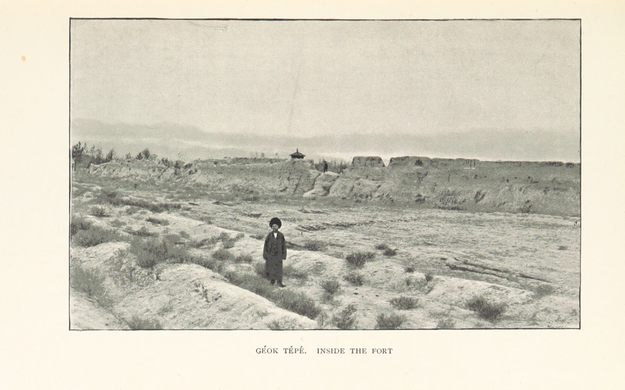Saparmurat Hajji Mosque
A memorial to the thousands of Turkmen soldiers and civilians who died in a bloody 1881 battle.
By 1880, Russia’s calculated, wide-sweeping campaign to conquer Central Asia was nearly complete. One of the last barriers to total domination of the region, however, were the Turkmen (or Tekke Turkomans), a loose confederation of tribes and soldiers without an organized, singular state.
Imperial Russia had tried to conquer what is now known as modern-day Turkmenistan a year earlier, launching an attack on the strategically located Goek Tepe fortress, where some 15,000 Turkmen soldiers and 5,000 women and children were positioned. The Russians, who were badly outnumbered, poorly managed, and ill-equipped, soon retreated.
Russian forces returned two years later with approximately 6,000 soldiers and a new general commanding the attack. While the Turkmen still greatly outnumbered the Russians, the foreign forces broke through after a 23-day siege by digging a tunnel under one of the fortress’s stone walls and detonating a mine, breaching the defensive lines. The Turkmen were forced to flee and by the time the battle was over, nearly 15,000 Turkmen soldiers and civilians were killed.
The Saparmurat Hajji Mosque was built on the orders of the first President of Turkmenistan, Saparmurat Atayevich Niyazov, on the site of the former Geok Tepe fortress to commemorate the Turkmen lives lost in this tragic battle—and, in typical post-Soviet authoritarian fashion, to honor Niyazov’s own pilgrimage to Mecca. The mosque subsequently became something of a national symbol for the country’s struggles and adorned the reverse of one of Turkmenistan’s 10,000 manat notes until a new series of currency was introduced in 2005.
Know Before You Go
The Saparmurat Hajji Mosque is located approximately 20 miles from Ashgabat, Turkmenistan's capital city. While open to the public, the mosque seems to receive very few visitors and is not used as a regular, everyday place of worship. A museum dedicated to the Battle of Geok Tepe is located on the mosque grounds, with entrance costing $5 USD per foreigner.
Community Contributors
Added by
Edited by
Plan Your Trip
The Atlas Obscura Podcast is Back!

















Follow us on Twitter to get the latest on the world's hidden wonders.
Like us on Facebook to get the latest on the world's hidden wonders.
Follow us on Twitter Like us on Facebook